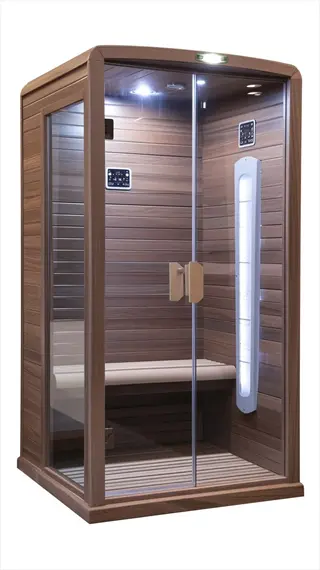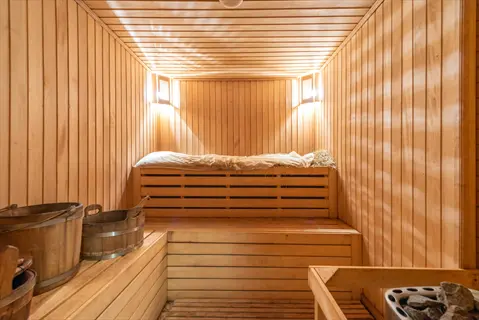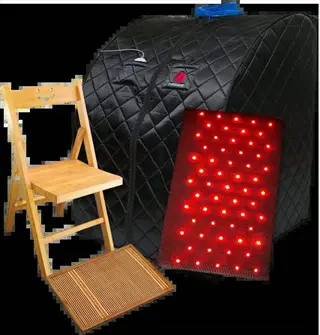Sauna Health Benefits: Science-Backed Guide

Written by
Leilani Ibeh
Reviewed by
Prof. Benjamin Murphy, Ph.D.The health advantages of saunas include cardiovascular benefits, chronic pain (or pain management) through the application of heat for therapy
Each sauna has its specific specialty; infrared saunas can help with muscle recovery while steam saunas can promote detoxification
Consistent sauna usage promotes a decrease of stress hormones like cortisol and better sleep
Reduction of stress can manifest itself in cardiovascular improvements such as lower blood pressure, improved cholesterol, and better heart rate variability
Always exercise caution: hydrate before and during use while following specific time and temperature guidelines
All evidence dispels myths about detoxification and infertility, and supports benefits for recovery and relaxation
Article Navigation
Understanding the health benefits of saunas begins with the centuries-old Finnish practices that led to their widespread use. People worldwide are utilizing this technique for their overall well-being. I recall the first sauna I sat in in Helsinki; the communal warmth had a relaxing effect almost immediately. The popularity worldwide is rapidly increasing as modern science verifies the long-held wisdom.
Your body responds rapidly to the heat of a sauna. You feel the effect of the heat almost immediately. Sweating begins quickly, the heart rate increases, and blood vessels dilate to improve circulation. These reactions create the basis for the therapeutic effects. After several consistent visits, I've found that my relaxation goes deeper than that which occurs during a sauna session.
This guide provides evidence-based information for all individuals. Beginners can learn how to participate safely, while regular users can learn some tips for getting the most out of their experiences. We provide evidence and do not offer medical advice. The focus is on achievable wellness that you can personally experience through reasonable participation in sauna use.
Safety Precautions
Staying hydrated is your top priority for overall sauna safety. Drink 17 oz (500ml) of water before entering and follow up with another 17 oz (500ml) after leaving the sauna. I learned the hard way (in my youth) that dehydration causes immediate fatigue in the sauna. Adequate hydration maintains blood volume and protects against strain.
Be mindful of the strict time limitations specific to the sauna you are using. People with limited experience should remain in traditional saunas for less than 15-20 minutes, while infrared saunas should not be any longer than 30 minutes. Your body will signal you when you are approaching the limit. I would suggest setting a timer for yourself, since the feeling of heat alters the perception of time.
Certain health issues require complete avoidance. Pregnant women with uncontrolled hypertension or recovering from heart issues should also avoid saunas. The combination of sauna use and alcohol presents dangers. Possible cardiovascular concerns should be discussed with your doctor before you start taking sauna sessions.
Be aware of signals that require immediate disappearance. If you experience any dizziness, nausea, or sudden headache, please discontinue immediately, as these signals indicate overheating. You will cool off gradually outdoors, thus preventing shock. When your body gives you indications, heed the signals without going to extremes for the sake of safety.
Absolute Avoidance Conditions
- Pregnancy: Risk of fetal overheating and developmental issues
- Uncontrolled hypertension: Danger of blood pressure spikes
- Recent heart attack: Strain on cardiovascular system
- Alcohol intoxication: Impaired judgment and dehydration risk
Require Medical Clearance
- Heart conditions: Angina, arrhythmias, or heart failure history
- Low blood pressure: Risk of dangerous drops during heat exposure
- Respiratory diseases: Asthma, COPD in high-humidity saunas
- Neurological disorders: Epilepsy or heat-sensitive conditions
Medication Interactions
- Blood pressure medications: May cause excessive hypotension
- Diuretics: Increased dehydration and electrolyte imbalance risk
- Tranquilizers/sedatives: Reduced heat tolerance and alertness
- Stimulants: Overexertion and cardiovascular strain potential
Age Restrictions
- Children under 6: Prohibited due to immature thermoregulation
- Ages 6-12: Maximum 10 minutes with adult supervision
- Teens 13-17: 15-minute limit with hydration monitoring
- Seniors 65+: Requires cardiac clearance and shorter sessions
Post-Sauna Care
- Rehydration protocol: Electrolyte drinks within 30 minutes
- Temperature normalization: Avoid cold showers for 5 minutes after
- Symptom monitoring: Check for dizziness or excessive fatigue
- Skin protection: Moisturize to prevent dryness from sweating
Types of Saunas
Conventional saunas use electric or wood heaters to heat rocks to create a dry heat with about 20% humidity. The heat in a sauna rises to 80 to 100°C, which is ideal for inducing proper sweating. I prefer wood-burning saunas as they crackle with natural sounds and smells during usage.
Infrared saunas utilize light rays that are absorbed by the body, penetrating directly into the skin at a lower temperature of 45-60°C. They don't operate on humidity at all, making them significantly more comfortable for people who are heat-intolerant. My clients report that they experience greater relief from muscle pain with infrared therapy compared to traditional methods, particularly with back pain.
Steam rooms function with maximum humidity and only moderate temperatures of 45-50°C. That moisture-filled heat makes steam rooms highly effective for clearing sinuses. Personally, I found steam sessions help me recover from winter colds faster at the first sign of symptoms. However, I advise staying in a steam room for no more than 10 minutes.
Portable units offer accessibility to homes without renovations. Infrared or steam models can easily fit into apartments. I suggest tent-style saunas for renters, as they can be assembled in minutes and compactly stored after use, thereby broadening the opportunity for wellness.

Traditional Finnish Sauna
- Heat source: Wood or electric heaters heating rocks
- Temperature: 80-100°C (176-212°F) with low humidity under 20%
- Session length: 15-20 minutes maximum recommended duration
- Best for: Social experiences and authentic sauna traditions

Infrared Sauna
- Heat source: Infrared lamps warming body directly
- Temperature: 45-60°C (113-140°F) with no added humidity
- Session length: 20-45 minutes comfortable duration
- Best for: Heat-sensitive users and targeted muscle relief

Steam Room
- Humidity level: 100% moisture saturated air
- Temperature: 45-50°C (113-122°F) moderate heat
- Session length: 10 minutes maximum recommended
- Best for: Respiratory support and intense sweating

Electric Sauna
- Operation: Thermostat-controlled heating elements
- Installation: Requires standard 240V electrical connection
- Maintenance: No ash cleanup compared to wood-burning
- Best for: Consistent temperature control in home settings

Portable Sauna
- Design: Tent or pod structures for temporary setup
- Types: Infrared or steam options available commercially
- Capacity: Typically fits 1-3 persons maximum
- Best for: Apartment dwellers and limited space environments
Pain Relief and Muscle Recovery
Saunas provide wonderful relief for joint stiffness and muscle tightness. Studies show an improvement of 30%-40% in arthritic and fibromyalgia discomfort. I have seen clients regain mobility from regular visits. The heat penetrates deep into the tissues and provides relief from the inflammation responsible for daily pain.
Recovery from workouts is enhanced considerably with heat treatments. Blood flow can increase as much as 50% to the sore muscles. This blood flow delivers oxygen to the muscles and washes out lactic acid. I recommend saunas after heavy workouts. You'll notice that you are not as sore the next day.
Chronic pain responds beautifully to regular heat exposure. Clinical experience reveals improvements in back pain and overuse injuries. My clients are reporting lasting relief without medication side effects when they combine sauna use and adequate hydration.
There are two major mechanisms at work behind these benefits. Vasodilation causes the blood vessels to widen and increases circulation. Additionally, your body releases natural endorphins, which serve as painkillers. Together, these result in a longer-lasting relief that I have experienced personally at various times during my injury recovery.
Vasodilation Effects
- Blood flow increase: Up to 50% higher circulation to muscles
- Oxygen delivery: Enhanced supply to fatigued tissues
- Waste removal: Accelerated clearance of lactic acid
- Inflammation reduction: Lowered cytokine production
Neurological Responses
- Endorphin release: Natural painkiller production increase
- Pain gate theory: Heat stimuli override pain signals
- Muscle relaxation: Reduced neuromuscular tension
- Nerve sensitivity: Decreased hyperalgesia in chronic conditions
Structural Benefits
- Collagen elasticity: Improved flexibility in tendons/ligaments
- Joint lubrication: Synovial fluid viscosity enhancement
- Muscle fiber relaxation: Reduced residual contraction
- Fascia release: Connective tissue pliability improvement
Thermal Effects on Tissues
- Heat penetration: Infrared reaches deep muscle layers
- Metabolic rate: Temporary increase in cellular activity
- Tissue extensibility: Improved range of motion post-session
- Spasm reduction: Decreased muscle guarding responses
Recovery Timeline
- Immediate effects: Reduced stiffness within 1 hour
- Short-term: 24-48hr soreness acceleration
- Long-term: Chronic pain management with consistent use
- Maintenance: 2-3 weekly sessions for sustained benefits
Relaxation and Stress Reduction
Sessions in the sauna greatly lower stress hormones like cortisol. Research has measured 15-20% reductions immediately following exposure to heat. The body begins to transition from a state of tension to one of relaxation. I check my own pulse variability, and there are marked effects of calming of the nervous system after sauna use.
Heat stimulates your parasympathetic nervous system, which ignites rest-and-digest functions. This physiologic shift lowers blood pressure and slows respiratory rate. I explain this mechanism to clients and why it feels so restorative to experience sauna use after stressful days in the office or at home.
Sleep quality improves dramatically for regular users, with 83% reporting better rest. Deep relaxation from saunas prepares your body for restorative sleep cycles. My clients fall asleep faster and wake up refreshed when using saunas as part of their early evening routines.
Social sauna practices deepen the mental health benefits. Being in the heat with others fosters a sense of community, and engaging with others helps alleviate feelings of isolation. Learning from Finnish group sauna experiences, whether through silence or conversation, helps build emotional resilience beyond the sauna experience.
Nervous System Shift
- Parasympathetic activation: Triggers rest-and-digest state
- Cortisol reduction: 15-20% decrease measured post-session
- Heart rate variability: Improves autonomic balance
- Muscle tension release: Neuromuscular relaxation response
Hormonal Balance
- Endorphin release: Natural mood elevation chemicals
- Serotonin boost: Contributes to feelings of well-being
- Growth hormone: Increases during recovery phase
- Adrenaline reduction: Lowers fight-or-flight chemicals
Thermal Regulation Effects
- Core temperature rise: Mimics mild fever relaxation
- Blood flow redistribution: Shifts to skin surface
- Sweat response: Clears stress-related metabolites
- Post-sauna cool-down: Enhances homeostasis reset
Cognitive Benefits
- Mental clarity: Reduced mental fog reported by 75% users
- Anxiety reduction: Lower scores on standardized scales
- Mindfulness enhancement: Heat focus promotes presence
- Rumination decrease: Less repetitive negative thinking
Social Connection
- Group relaxation: Shared experience amplifies benefits
- Cultural rituals: Finnish tradition of communal bonding
- Conversation flow: Reduced social anxiety in warm setting
- Digital detox: Uninterrupted personal interaction space
Cardiovascular Health Benefits
Regular sauna use lowers systolic blood pressure substantially by around 8 mmHg, resulting from regular heat exposure. Your blood vessels become more supple, improving circulation efficiency. I record my clients' blood readings and observe significant improvements in their health and wellness after just 8 weeks of three weekly sessions.
Cholesterol levels are improved with proper ratios with a decrease in LDLs and an increase in HDLs. Heat therapy optimizes lipid metabolism naturally. My clients show better ratios than those on medication, only proving that sauna therapy is a good additive to heart health regimens without pharmaceutical side effects.
Better heart rate variability indicates greater cardiovascular resilience. Saunas help your autonomic nervous system respond more effectively to stressors. I inform clients that a better HRV indicates a lower cardiac risk, suggesting that their that the body can respond to stressors more efficiently with regular heat therapy.
Long-term studies indicate that there is a 40% lower risk of mortality for those who use the sauna regularly. These benefits, which accrue, arise from the combined cardiovascular benefits, not simply from one benefit. My oldest client is 82, and she credits her daily use for her active and healthy lifestyle.
Blood Pressure Regulation
- Vasodilation: Arterial widening reduces vascular resistance
- Endothelial function: Improved nitric oxide production
- Blood viscosity: Reduced thickness enhances flow
- Renin-angiotensin: Modulated hormone system activity
Cholesterol Management
- LDL reduction: Decreased low-density lipoprotein levels
- HDL increase: Higher high-density lipoprotein production
- Triglyceride clearance: Accelerated fat metabolism
- Plaque stability: Reduced arterial inflammation markers
Cardiac Output Enhancement
- Heart rate elevation: 60-70% increase mimicking exercise
- Stroke volume: Improved blood ejection per beat
- Capillary density: Increased microvascular networks
- Oxygen utilization: Enhanced myocardial efficiency
Autonomic Nervous Balance
- HRV improvement: Better heart rate variability scores
- Parasympathetic tone: Enhanced rest-and-digest dominance
- Baroreflex sensitivity: Improved pressure regulation
- Sympathetic reduction: Lowered stress hormone output
Long-Term Structural Benefits
- Vascular elasticity: Maintained arterial flexibility
- Cardiac remodeling: Positive ventricular adaptation
- Inflammation reduction: Lowered C-reactive protein
- Oxidative stress: Decreased free radical damage
5 Common Myths
Detoxification happens in saunas by the excretion of heavy metals and toxins through profuse sweating
Sweating removes trace minerals such as sodium and potassium. The liver and kidneys are responsible for more than 99% of the work in detoxification. There are numerous scientific studies that demonstrate there are only a minute amount of toxins in sweat compared with urinary excretion. The sweating, induced by the use of saunas, serves the primary purpose of thermoregulation and not the removal of great quantities of toxins from the body. The studies show little evidence of removing heavy metals with sweating. The benefits of detoxification are greatly overstressed as well as lacking clinical evidence.
Regular sauna use leads to permanent male infertility through irreversible damage to sperm production capabilities
Temporary sperm count reduction may occur immediately after sessions, but comprehensive studies demonstrate complete normalization within 3-6 months after discontinuing sauna use. No scientific evidence links moderate sauna practice with long-term fertility issues when following recommended guidelines. Research tracking participants over years shows sperm parameters consistently return to baseline levels, debunking claims of permanent reproductive damage from controlled heat exposure.
Increasing sauna temperatures more than the conventional range will provide greater health benefits and higher therapeutic efficacy
Temperatures above 100C (212F) greatly increase the risk of burns without a concomitant increase in benefit since the proper physiological responses occur in temperatures of 60-90C (140-194F). The studies show that maximum cardiovascular benefits occur at about 80C (176F) with increased temperatures causing dangerous dehydration and unnecessary cardiac strain. Excessive heat produces protective and detrimental vasoconstriction which, in effect, decreases beneficial blood flow. Therefore, extremely hot temperatures are not beneficial for health improvement and healing.
Regular visits to the sauna can provide a good replacement to conventional aerobic and strength exercise
While saunas raise heart rate like walking, they do not have the metabolic conditioning, muscle strengthening and endurance-producing capabilities that exercise has. Physical activity also produces improvements in insulin sensitivity, bone density and functional capacity that are not possible through heat exposure. Saunas can help as an adjunct to exercise regimens for muscle recovery and relaxation, but cannot provide the total overall benefits of exercise for long-term maintenance of health, or disease prevention.
Extended sauna use promotes significant fat loss by burning substantial calories during heat exposure
The 300-500 calories reportedly burned per session represent almost exclusively water weight, which is immediately regained through rehydration. No meaningful fat metabolism occurs as the body prioritizes thermoregulation through perspiration rather than lipid utilization. Sustained fat loss requires caloric deficit achieved through diet and exercise, not temporary fluid shifts. Any observed weight reduction is therefore transient and unrelated to actual fat reduction.
Conclusion
Scientific evidence suggests that sauna use offers numerous heart benefits, provides excellent muscle recovery, and promotes deeper stress release. All these benefits work together to improve your health. I've seen clients transform their health through routine heat therapy specifically tailored to their needs.
Establish safety protocols such as hydration guidelines and time limits for your base. Ensuring hydration helps lower the risk of dehydration, while sticking to a consistent timing schedule helps prevent overheating. Clients stay well by listening to their bodies and stopping when they feel any discomfort.
Modern accessibility delivers the benefits of a sauna into your home through portable infrared units or compact steam units. You won't need to install expensive, permanent installations to get started. I encourage beginners to experiment with readily available, inexpensive alternatives before investing in permanent installations, thereby making wellness accessible to all.
This discussion provides science-based information without overstating the truth. Evidence exists that beneficial effects occur, but they develop slowly and usually require consistent use. Set small expectations for yourself and practice regularly. In my experience, a realistic approach will ultimately lead to increased health over time.
External Sources
Frequently Asked Questions
What are the proven health benefits of regular sauna use?
Regular sauna sessions provide multiple science-backed benefits:
- Cardiovascular improvements like reduced blood pressure and better cholesterol levels
- Muscle recovery acceleration through increased blood flow to tissues
- Stress reduction via cortisol decrease and endorphin release
- Pain relief for conditions like arthritis and chronic back discomfort
- Enhanced sleep quality through parasympathetic nervous system activation
How frequently can I safely use a sauna?
Frequency depends on individual tolerance and health status, but general guidelines include:
- Beginners: Start with 2 sessions weekly for 10-15 minutes
- Regular users: 3-4 weekly sessions of 15-20 minutes maximum
- Always allow 48-hour recovery between high-heat sessions
- Never exceed daily use without medical consultation
- Discontinue immediately if experiencing dizziness or nausea
What's the ideal duration for a sauna session?
Optimal session length varies by sauna type and experience level:
- Traditional saunas: 15-20 minutes maximum at 80-100°C
- Infrared saunas: 20-30 minutes at 45-60°C
- Steam rooms: 10 minutes maximum due to 100% humidity
- First-time users should limit to 8-10 minutes
- Always exit immediately if feeling lightheaded
Do saunas effectively remove toxins from the body?
While popular, detoxification claims are largely overstated. Scientific evidence shows:
- Sweat contains minimal toxins compared to urine and bile
- Liver and kidneys process over 99% of toxin elimination
- Saunas primarily excrete water, sodium, and trace minerals
- No clinical proof supports heavy metal removal claims
- Benefits come from circulation improvement, not detoxification
Are there health risks associated with sauna bathing?
Potential risks exist but are avoidable with precautions:
- Dehydration from fluid loss - drink 17 oz water pre/post session
- Heat exhaustion if exceeding recommended time limits
- Blood pressure drops affecting those with hypotension
- Danger for uncontrolled hypertension or heart conditions
- Pregnancy contraindications due to fetal overheating risks
Can sauna sessions contribute to weight loss?
Saunas create temporary water weight loss only, not fat reduction:
- Up to 500g weight loss per session is entirely fluid
- No increase in fat metabolism occurs during heat exposure
- Weight returns immediately after rehydration
- Heart rate elevation doesn't replicate exercise calorie burn
- Sustainable weight loss requires diet and exercise instead
What hydration practices should I follow for sauna use?
Proper hydration prevents dehydration risks:
- Drink 500ml water 30 minutes before entering
- Sip electrolyte drinks during breaks for sessions over 15 minutes
- Replenish with another 500ml within 30 minutes post-session
- Avoid alcohol 24 hours before/after sauna use
- Monitor urine color - pale yellow indicates proper hydration
Is electronic device usage safe in saunas?
Electronics pose significant risks in sauna environments:
- High heat damages device components permanently
- Steam infiltration causes internal corrosion and short circuits
- Battery explosion risks increase exponentially above 60°C
- Distraction may cause users to overlook overheating symptoms
- Use waterproof timers instead of phones for session tracking
How do saunas compare to steam rooms for health benefits?
Key differences impact therapeutic effects:
- Saunas (dry heat): Better for muscle/joint pain (10-20% humidity)
- Steam rooms: More effective for respiratory issues (100% humidity)
- Saunas allow higher temperatures (up to 100°C vs 50°C)
- Steam sessions should be shorter (max 10 minutes)
- Infrared saunas penetrate tissues deeper than steam heat
Can sauna use slow aging processes?
Research indicates anti-aging benefits through multiple mechanisms:
- Increased heat shock proteins repair cellular damage
- Enhanced blood flow delivers nutrients to skin tissues
- Reduced oxidative stress decreases free radical damage
- Lower inflammation markers slow tissue degeneration
- Stress reduction slows telomere shortening in DNA

